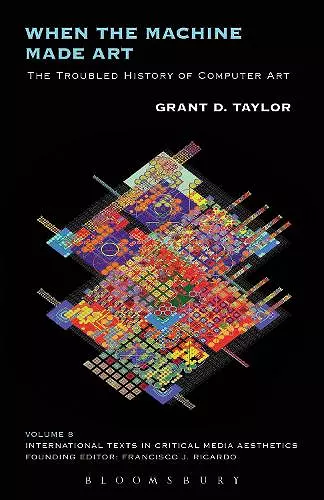When the Machine Made Art
The Troubled History of Computer Art
Format:Paperback
Publisher:Bloomsbury Publishing PLC
Published:5th Jun '14
Currently unavailable, and unfortunately no date known when it will be back

Examines the cultural and critical response to computer art, by identifying the destabilizing forces that affect, shape, and eventually fragment the computer art movement.
Considering how culturally indispensable digital technology is today, it is ironic that computer-generated art was attacked when it burst onto the scene in the early 1960s. In fact, no other twentieth-century art form has elicited such a negative and hostile response. When the Machine Made Art examines the cultural and critical response to computer art, or what we refer to today as digital art. Tracing the heated debates between art and science, the societal anxiety over nascent computer technology, and the myths and philosophies surrounding digital computation, Taylor is able to identify the destabilizing forces that shape and eventually fragment the computer art movement.
Taylor's 'troubled history of computer art' is subtle, complex, multi-layered and often paradoxical, so any attempt to summarize or synthesize its content fails to convey the scope and depth of what is covered ... I intend to champion Taylor’s book whenever the lament arises about why the art world takes no notice of mathematical art ... I will urge everyone I know who has an interest in using the computer in any significant way in his or her art practice to read Taylor’s book for the cautionary lessons it has to offer. -- Gary Greenfield, University of Richmond, USA * Journal of Mathematics and the Arts *
Taylor recovers and reassembles the fractured history of "computer art" from 1963, when the term came into use, until 1989, when "digital art" and "new media" became the preferred terms […] Taylor’s approach is integrative. He reconstructs the history of computer art not by isolating it from its scientific and mathematical nature but by combining that context with the "art and technology" and conceptual art movements of the 1960s. Summing Up: Recommended. Graduate students and researchers/faculty. -- E. K. Mix, Butler University * CHOICE *
How astonishing that the pioneers of computer, digital, algorithmic, programming, and mash-up art are largely unknown at the very moment when the computer, or more specifically its handheld, lap bound, or otherwise omnipresent progeny are transforming virtually every aspect of existence! I read this, fascinated by the continued relevance of the artists (and their disputes) and delighted to know that finally, with this publication, there exists a portrait of an evolving movement that has worked assiduously at the boundaries of the art world for fifty years. -- Hannah B Higgins, Professor of Art History, University of Illinois Chicago, USA
By questioning the reasons for which art critics, artists and curators rejected computer-generated artefacts during the 1960s, 1970s and 1980s, Grant Taylor makes a significant contribution to the historiography of 20th century culture. -- Margit Rosen, Researcher and Curator, ZKM | Center for Art and Media Karlsruhe, Germany
Although computer-generated art was largely ignored by the art establishment in the 1960s and 70s, it's now viewed in a very different light. Grant Taylor's book provides an excellent - and much needed -overview of the beginnings of digital art and design. -- Douglas Dodds, Senior Curator, Victoria and Albert Museum, UK
ISBN: 9781623568849
Dimensions: unknown
Weight: 408g
352 pages